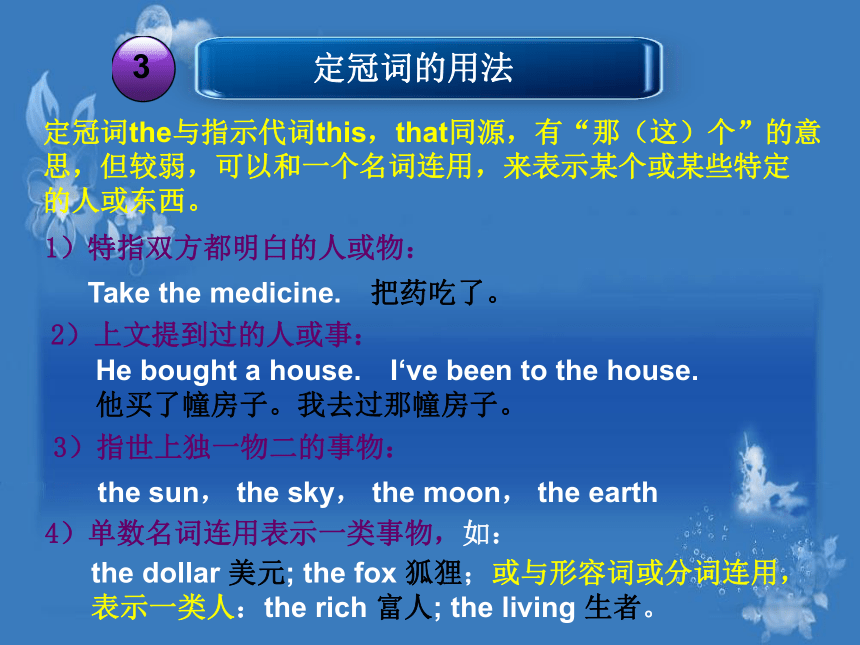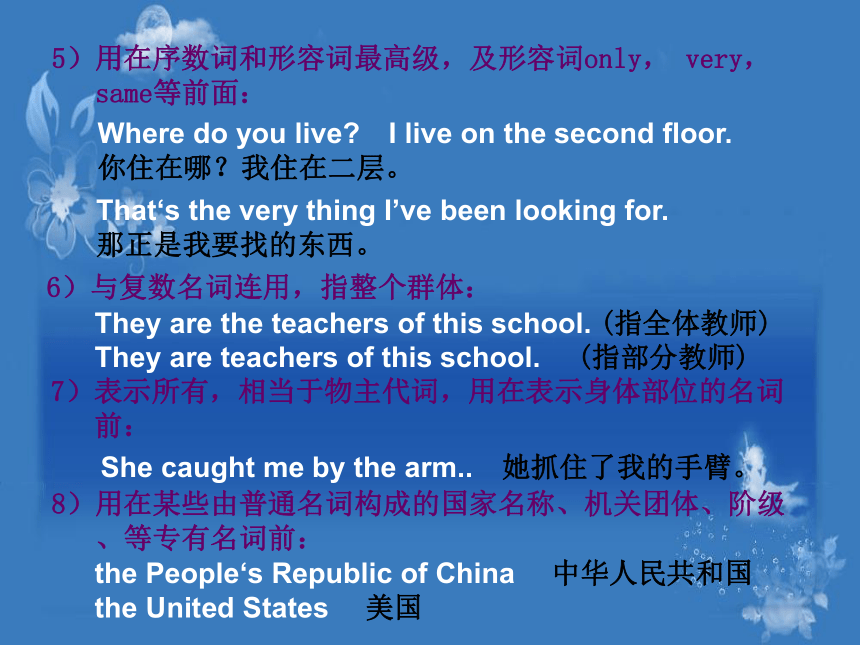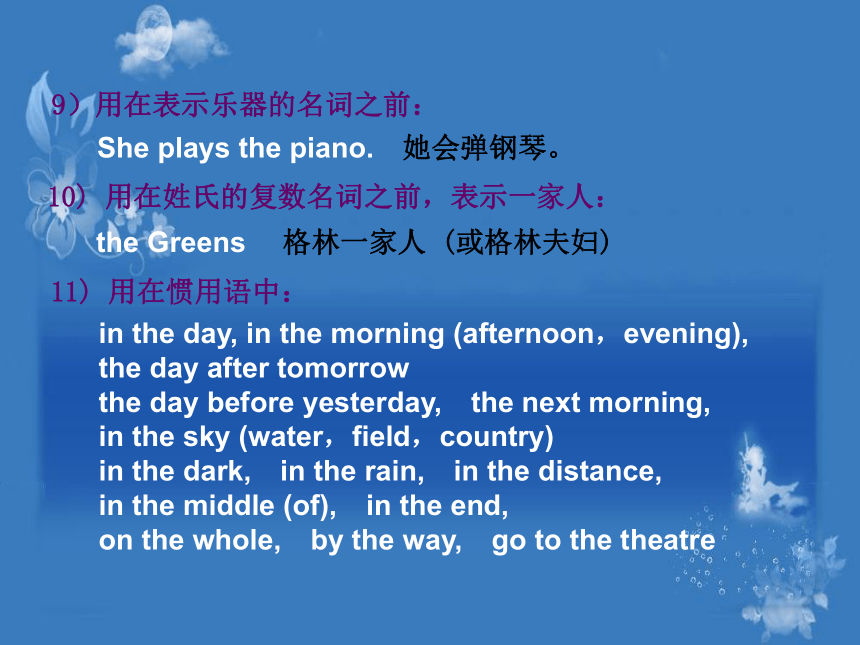2017青海中考语法专题《冠词》课件(共16张PPT)
文档属性
| 名称 | 2017青海中考语法专题《冠词》课件(共16张PPT) |  | |
| 格式 | zip | ||
| 文件大小 | 1.5MB | ||
| 资源类型 | 教案 | ||
| 版本资源 | 人教新目标(Go for it)版 | ||
| 科目 | 英语 | ||
| 更新时间 | 2017-01-13 21:38:36 | ||
图片预览







文档简介
课件16张PPT。冠词是虚词,本身不能单独使用,也没有词义,它用在
名词的前面,帮助指明名词的含义。英语中的冠词有三
种,一种是定冠词(the Definite Article),另一种是
不定冠词(the Indefinite Article),还有一种是零冠词
(Zero Article)。
不定冠词a (an)与数词one 同源,是“一个”的意思。a用于
辅音音素前,一般读作[e],而an则用于元音音素前,一般
读做[en]。
1) 表示"一个",意为one;指某人或某物,意为a certain。
2) 代表一类人或物。3) 词组或成语。
A Mr. Ling is waiting for you. A knife is a tool for cutting with.
Mr. Smith is an engineer. a little / a few / a lot / a type of / a pile / a great many / many a / as a rule / in a hurry / in a minute / in a word / in a short while / after a while / have a cold / have a try / keep an eye on / all of a sudden比较“a”和“an”的不同用法a用于发音以辅音开头的词前,an用于发音以元音开头的词前:a university student 一个大学生
an umbrella 一把雨伞a European 一个欧洲人
an Englishman 一个英国人a one-eyed man 一个独眼人
an old man 一个老人a house 一栋房子
an hour 一个小时
an honest boy 一个诚实的孩子a man 一位男士
an “m” 一个“m”定冠词the与指示代词this,that同源,有“那(这)个”的意
思,但较弱,可以和一个名词连用,来表示某个或某些特定
的人或东西。1)特指双方都明白的人或物:2)上文提到过的人或事: Take the medicine. 把药吃了。He bought a house. I‘ve been to the house.
他买了幢房子。我去过那幢房子。3)指世上独一物二的事物:the sun, the sky, the moon, the earth 4)单数名词连用表示一类事物,如:
the dollar 美元; the fox 狐狸;或与形容词或分词连用,
表示一类人:the rich 富人; the living 生者。5)用在序数词和形容词最高级,及形容词only, very, same等前面:Where do you live? I live on the second floor. 你住在哪?我住在二层。That‘s the very thing I’ve been looking for. 那正是我要找的东西。6)与复数名词连用,指整个群体:They are the teachers of this school. (指全体教师) They are teachers of this school. (指部分教师)7)表示所有,相当于物主代词,用在表示身体部位的名词 前:She caught me by the arm.. 她抓住了我的手臂。8)用在某些由普通名词构成的国家名称、机关团体、阶级 、等专有名词前:the People‘s Republic of China 中华人民共和国 the United States 美国 9)用在表示乐器的名词之前: She plays the piano. 她会弹钢琴。10) 用在姓氏的复数名词之前,表示一家人:the Greens 格林一家人 (或格林夫妇)11) 用在惯用语中:in the day, in the morning (afternoon,evening), the day after tomorrow the day before yesterday, the next morning, in the sky (water,field,country) in the dark, in the rain, in the distance, in the middle (of), in the end, on the whole, by the way, go to the theatre 1)国名,人名前通常不用定冠词:England,Mary;2)泛指的复数名词,表示一类人或事物时,可不用定冠词;They are teachers. 他们是教师。3)抽象名词表示一般概念时,通常不加冠词:Failure is the mother of success. 失败乃成功之母。4)物质名词表示一般概念时,通常不加冠词,当表示特定
的意思时,需要加定冠词:Man cannot live without water. 人离开水就无法生存。5)在季节、月份、节日、 假日、日期、星期等表示时间的名 词之前,不加冠词:We go to school from Monday to Friday. 我们从星期一到星期五都上课。 6)在称呼或表示官衔,职位的名词前不加冠词:The guards took the American to General Lee. 士兵们把这个美国人送到李将军那里。7)在三餐、球类运动和娱乐运动的名称前,不加冠词 如:have breakfast,play chess 8)当两个或两个以上名词并用时,常省去冠词:I can‘t write without pen or pencil. 没有钢笔和铅笔,我就写不了字。9)当by 与火车等交通工具连用,表示一种方式时,中间无 冠词:by bus,by train; 11)不用冠词的序数词:10)有些个体名词不用冠词;如: school,college,prison,market,hospital,bed, table,class,town,church,court 等个体名词,
直接置于介词后,表示该名词的深层含义;go to hospital 去医院看病 go to the hospital 去医院 (并不是去看病,而是
有其他目的)a. 序数词前有物主代词 b. 序数词作副词 He ran first in the race. c. 在固定词组中 at first, first of all, from first to last12)如果名词前已有this, that, these, those, whose, which, my, your, their, his, her, its, some, every等一类词时, 就不再加定冠词,因为这时它已经比较明白了。试比较:有无冠词,意义不同at table 在进餐 at the table 在餐桌房in hospital 在住院 in the hospital 在医院里in school 在学习;在学校上课 in the school 在学校里out of question 不成问题;豪无疑问 out of the question 不可能;办不到go to school 上学 go to the school 到学校去go to hospital 去看病 go to the hospital 到医院去go to bed 去睡觉 go to the bed 向那张床走去名词是秃子,常要戴帽子。可数名词单,须用a或an。
辅音前用a,an用元音前。若为特指时,则须用定冠。
复数不可数,泛指the不见。碰到代词时,冠词均不现。1) 两个形容词都有冠词,表示两个不同东西。He raises a black and a white cat. 他养了一只黑猫和一只白猫。 The black and the white cats are hers. 这只黑猫和白猫都是他的。2) 如后一个形容词无冠词,则指一物。He raises a black and white cat. 他养了一只花猫。1) 不定冠词位置不定冠词常位于名词或名词修饰语前。注意: a. 位于下列形容词之后: such,what,many,half,I have never seen such an animal. Many a man is fit for the job.b. 当名词前的形容词被副词as, so, too, how, however, enough修饰时,不定冠词应放在形容词之后:It is as pleasant a day as I have ever spent. So short a time. Too long a distance.c. quite,rather与单数名词连用,冠词放在其后。 但当rather,quite 前仍有形容词,不定冠词放其前后均 可。如:quite a lot d. 在as,though 引导的让步状语从句中,当表语为形容词 修饰的名词时,不定冠词放形容词后: Brave a man though he is,he trembles at the sight of snakes. 他尽管勇敢,可见到蛇还是发抖。当名词被比较级形容词修饰时,不定冠词通常置于比较级
形容词之后。2) 定冠词位置定冠词通常位于名词或名词修饰语前,但放在all, both, double,half,twice,three times等词之后,名词之前。All the students in the class went out. 班里的所有学生都出去了。Thank you!
表示一类人:the rich 富人; the living 生者。5)用在序数词和形容词最高级,及形容词only, very, same等前面:Where do you live? I live on the second floor. 你住在哪?我住在二层。That‘s the very thing I’ve been looking for. 那正是我要找的东西。6)与复数名词连用,指整个群体:They are the teachers of this school. (指全体教师) They are teachers of this school. (指部分教师)7)表示所有,相当于物主代词,用在表示身体部位的名词 前:She caught me by the arm.. 她抓住了我的手臂。8)用在某些由普通名词构成的国家名称、机关团体、阶级 、等专有名词前:the People‘s Republic of China 中华人民共和国 the United States 美国 9)用在表示乐器的名词之前: She plays the piano. 她会弹钢琴。10) 用在姓氏的复数名词之前,表示一家人:the Greens 格林一家人 (或格林夫妇)11) 用在惯用语中:in the day, in the morning (afternoon,evening), the day after tomorrow the day before yesterday, the next morning, in the sky (water,field,country) in the dark, in the rain, in the distance, in the middle (of), in the end, on the whole, by the way, go to the theatre 1)国名,人名前通常不用定冠词:England,Mary;2)泛指的复数名词,表示一类人或事物时,可不用定冠词;They are teachers. 他们是教师。3)抽象名词表示一般概念时,通常不加冠词:Failure is the mother of success. 失败乃成功之母。4)物质名词表示一般概念时,通常不加冠词,当表示特定
的意思时,需要加定冠词:Man cannot live without water. 人离开水就无法生存。5)在季节、月份、节日、 假日、日期、星期等表示时间的名 词之前,不加冠词:We go to school from Monday to Friday. 我们从星期一到星期五都上课。 6)在称呼或表示官衔,职位的名词前不加冠词:The guards took the American to General Lee. 士兵们把这个美国人送到李将军那里。7)在三餐、球类运动和娱乐运动的名称前,不加冠词 如:have breakfast,play chess 8)当两个或两个以上名词并用时,常省去冠词:I can‘t write without pen or pencil. 没有钢笔和铅笔,我就写不了字。9)当by 与火车等交通工具连用,表示一种方式时,中间无 冠词:by bus,by train; 11)不用冠词的序数词:10)有些个体名词不用冠词;如: school,college,prison,market,hospital,bed, table,class,town,church,court 等个体名词,
直接置于介词后,表示该名词的深层含义;go to hospital 去医院看病 go to the hospital 去医院 (并不是去看病,而是
有其他目的)a. 序数词前有物主代词 b. 序数词作副词 He ran first in the race. c. 在固定词组中 at first, first of all, from first to last12)如果名词前已有this, that, these, those, whose, which, my, your, their, his, her, its, some, every等一类词时, 就不再加定冠词,因为这时它已经比较明白了。试比较:有无冠词,意义不同at table 在进餐 at the table 在餐桌房in hospital 在住院 in the hospital 在医院里in school 在学习;在学校上课 in the school 在学校里out of question 不成问题;豪无疑问 out of the question 不可能;办不到go to school 上学 go to the school 到学校去go to hospital 去看病 go to the hospital 到医院去go to bed 去睡觉 go to the bed 向那张床走去名词是秃子,常要戴帽子。可数名词单,须用a或an。
辅音前用a,an用元音前。若为特指时,则须用定冠。
复数不可数,泛指the不见。碰到代词时,冠词均不现。1) 两个形容词都有冠词,表示两个不同东西。He raises a black and a white cat. 他养了一只黑猫和一只白猫。 The black and the white cats are hers. 这只黑猫和白猫都是他的。2) 如后一个形容词无冠词,则指一物。He raises a black and white cat. 他养了一只花猫。1) 不定冠词位置不定冠词常位于名词或名词修饰语前。注意: a. 位于下列形容词之后: such,what,many,half,I have never seen such an animal. Many a man is fit for the job.b. 当名词前的形容词被副词as, so, too, how, however, enough修饰时,不定冠词应放在形容词之后:It is as pleasant a day as I have ever spent. So short a time. Too long a distance.c. quite,rather与单数名词连用,冠词放在其后。 但当rather,quite 前仍有形容词,不定冠词放其前后均 可。如:quite a lot d. 在as,though 引导的让步状语从句中,当表语为形容词 修饰的名词时,不定冠词放形容词后: Brave a man though he is,he trembles at the sight of snakes. 他尽管勇敢,可见到蛇还是发抖。当名词被比较级形容词修饰时,不定冠词通常置于比较级
形容词之后。2) 定冠词位置定冠词通常位于名词或名词修饰语前,但放在all, both, double,half,twice,three times等词之后,名词之前。All the students in the class went out. 班里的所有学生都出去了。Thank you!
同课章节目录
- 词法
- 名词
- 动词和动词短语
- 动词语态
- 动词时态
- 助动词和情态动词
- 非谓语动词
- 冠词
- 代词
- 数词和量词
- 形容词副词及其比较等级
- 介词和介词短语
- 连词和感叹词
- 构词法
- 相似、相近词比较
- 句法
- 陈述句
- 一般疑问句和否定疑问句
- 特殊疑问句及选择疑问句
- 反意疑问句
- 存在句(There be句型)
- 宾语从句
- 定语从句
- 状语从句
- 主谓一致问题
- 简单句
- 并列句
- 复合句
- 主谓一致
- 主、表语从句
- 名词性从句
- 直接引语和间接引语
- 虚拟语气
- 感叹句
- 强调句
- 倒装句
- 祈使句
- 句子的成分
- 句子的分类
- 题型专区
- 单项选择部分
- 易错题
- 完形填空
- 阅读理解
- 词汇练习
- 听说训练
- 句型转换
- 补全对话
- 短文改错
- 翻译
- 书面表达
- 任务型阅读
- 语法填空
- 其他资料
